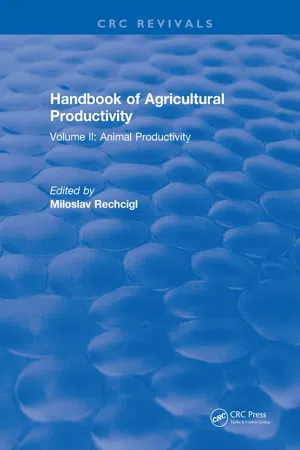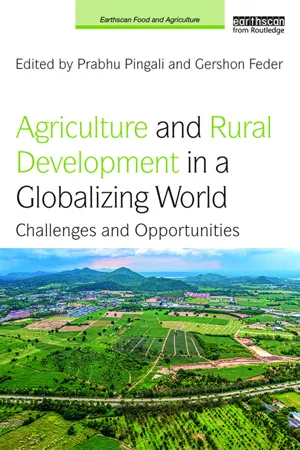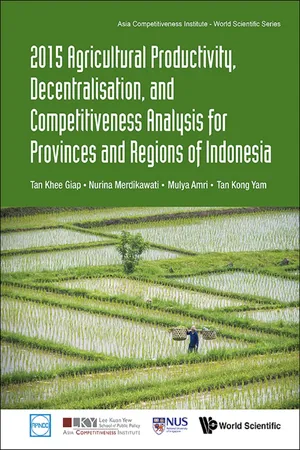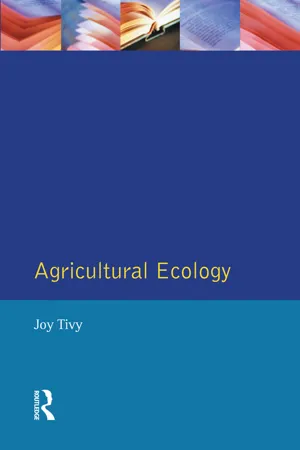Geography
Agriculture Productivity
Agricultural productivity refers to the efficiency of agricultural production, typically measured by the amount of output produced per unit of input, such as land, labor, or capital. It is a key factor in determining the overall economic performance and food security of a region or country. Factors influencing agricultural productivity include technology, infrastructure, climate, and government policies.
Written by Perlego with AI-assistance
Related key terms
5 Key excerpts on "Agriculture Productivity"
- eBook - ePub
Handbook of Agricultural Productivity
Volume II: Animal Productivity
- Miloslav Rechcigl(Author)
- 2018(Publication Date)
- CRC Press(Publisher)
Agricultural Productivity: Potential And Constraints Theodore C. ByerlyProduction Resources: Soil, Water, And Energy
Agricultural productivity may be measured in terms of total production and yield per hectare or animal unit. Productivity so defined is determined by quantity and quality of resources used, the technology applied in their use, and the impact of weather, pests, and diseases.The principal resources used are soil, water, nutrients (both plant and animal), seed and livestock breeding animals, crop, machine, and livestock inventories, and energy and pesticides. The productive use of these resources is limited by the availability and use of capital credit and management skills.Soil, water, and human resources available in 1977 and potentially available for use in the year 2000 are shown in Table 1.The estimates of energy available for agricultural production in relation to arable land are of particular interest. While these estimates are very crude approximations, the differences among the developing countries and more developed market and centrally planned economies are larger than any probable error in these estimates. The estimated hp/ha in the developed market economies (DME) is about 1.3, for centrally planned economies (CPE) about 0.52, for less developed countries (LDC) about 0.38, and for the U. S. about 1.17. Human and animal labor comprise more than 80% of the total hp equivalent available in the LDC compared to less than 5% in DME. Availability of untiring, mechanical power enables cultivators in DME to plow, plant, and reap during brief periods of favorable weather while LDC cultivators are much more constrained by weather. Scarcity of fossil fuel may continue to make human and animal power more cost effective than mechanical power on the millions of small holdings in LDCs.52Crop Production and Yield
Average production and yields of major crops are summarized for 1977 (Table 2). Drought in Australia reduced yield and production in Oceania. - eBook - ePub
Agriculture and Rural Development in a Globalizing World
Challenges and Opportunities
- Prabhu Pingali, Gershon Feder(Authors)
- 2017(Publication Date)
- Routledge(Publisher)
“Isolation and Agricultural Productivity.” Agricultural Economics 39 (1): 1–15. Tilman, D. 1999. “Global Environmental Impacts of Agricultural Expansion: The Need for Sustainable and Efficient Practices.” Proceedings of the National Academy of Sciences of the United States of America 96 (11): 5995–6000. Weir, S. 1999. “The Effects of Education on Farmer Productivity in Rural Ethiopia.” Report No. WPS 99–7, Centre for the Study of African Economies, Department of Economics, University of Oxford, Oxford. World Bank. 2002. Road Financing and Road Funds. http://www.worldbank.org/en/topic/transport World Bank. 2015. “The Cost of the Gender Gap in Agricultural Productivity in Malawi, Tanzania, and Uganda.” Joint Report No. 100234 of UN Women, the United Nations Development Programme–United Nations Environment Programme–Poverty-Environment Initiative (UNDP-UNEP PEI) Africa, and the World Bank, Washington, DC. World Bank. 2016. Indicators. Agriculture & Rural Development. http://data.worldbank.org/indicator 3 Revisiting the farm size–productivity relationship New evidence from sub-Saharan African countries Pasquale Lucio Scandizzo and Sara Savastano Introduction The inverse relationship (IR) between land productivity and farm size has emerged as an empirical regularity since the early studies (1950–1960) on Indian agriculture. 1 Although somewhat contrary to expectations, the IR became popular probably because it tended to support peasant farming as a more human and efficient alternative to capitalistic, large-scale agriculture. It also suggested that investing in small, family farms might help solve problems, such as food security and income inequality - eBook - ePub
2015 Estimation of Agricultural Productivity and Annual Update of Competitiveness Analysis for Greater China
Optimising Agricultural Productivity and Promoting Innovation Driven Growth
- Khee Giap Tan, Randong Yuan, Teleixi Xie(Authors)
- 2016(Publication Date)
- WSPC(Publisher)
The migration of people from rural to urban areas and the expansion of cities and towns along with rapid conversion of agricultural land into industrial zones all across China, possibly the largest and fastest urbanisation process to ever happen in human history, also serve to further strain the supply of agricultural land and shift manpower away from the primary sector. Thus, the two major inputs of the production function for agriculture, namely labour and land, offer no reassuring outlook as long as the certainty of growth in agricultural products is of concern; the number of farmers is actually dwindling, while the acreage of farmlands stagnates to say the least.All these necessitate a significant improvement in agricultural productivity. Against such a backdrop, achieving and sustaining sufficient level of agricultural productivity is paramount if China is to ensure food security in the coming years. Ensuring significant productivity growth in agriculture will also help raise farm wages, hence enhancing the welfare and standard of living of rural dwellers and providing them with the incentives to continue to work and invest in the agriculture sector. Therefore, in this chapter, we choose to study agricultural productivity of China and will pay special attention to analysing the Total Factor Productivity (TFP) for China’s provincial level economies.The objective of our study is to examine agricultural productivity growth at the provincial level in China with a time series dataset covering the last two decades. We will take a non-parametric approach to measure agricultural TFP growth in China among the provinces. Such a methodology helps to break down the change in TFP into two components, namely the technological change (TC) and the technical efficiency change (TEC), which relate broadly to the progress in technology (i.e. shift in the production frontier) and better resource utilisation through more efficient management, respectively.This research is driven by academic interests that serve as a modest spur to induce healthy debate and further research on this seemingly low profile but critical topic. The results of such empirical investigation will enable us to have an updated understanding of the key factors that determine the growth profile of the agricultural sector at the subnational level in China, thereby helping relevant stakeholders from the public and private sectors to make more informed decisions. - Khee Giap Tan, Nurina Merdikawati;Mulya Amri;Kong Yam Tan(Authors)
- 0(Publication Date)
- WSPC(Publisher)
According to Ministry of Agriculture (2015b), R&D activities for 2010–2014 produced 49 newly improved varieties of rice; 27 newly improved varieties of corn and cereal; 114 newly improved varieties of horticultural plants; 38 newly improved varieties/clones of estate crops; 47 newly improved varieties of livestock; and 44 post-harvest technologies. Dissemination is also crucial in ensuring that the technology and innovation are properly adopted by the relevant stakeholders. From 2010 to 2014, Ministry of Agriculture disseminated 1,307 technologies to end users. During that period, there were 453 innovations from IAARD whose intellectual properties had been registered, of which 294 had received intellectual property certificates.To understand better how these agricultural policies affect the dynamics of agricultural productivity across provinces in Indonesia, the following sections will start building up the corresponding analysis, starting from literature review, followed by description of methodology, data and eventually the findings from the study.5.4 LITERATURE REVIEWVarious literatures have examined agricultural productivity in Indonesia with largely varied findings owing to the use of different methodologies, time periods, specification of variables and data sources. “Productivity” is often interpreted in several ways. In its annual agricultural statistics, Ministry of Agriculture (2014) reported productivity figure based on total agricultural production in kilogram per hectare of land. To account for labour productivity, the calculation will take into account the agricultural output per worker. In Table 5.4 , we only summarised the studies on agriculture in Indonesia that have specifically estimated Total Factor Productivity (TFP) which is the portion of output not explained by the amount of inputs used in production. As such, its level is determined by how efficiently and intensely the inputs are utilised in production.Relying on more than four decades of time series data, Avila and Evenson (2010) and Fuglie (2010) reported a relatively modest TFP growth, 2% and 1.8%, respectively. They further decomposed the TFP growth into different periods of analysis. In Avila and Evenson (2010), the TFP growth was higher in 1961–1980 at around 4.4% than during 1981–2001 with a negative productivity growth of –0.4%. Similar trends can be found in Fuglie (2010) who reported decadal TFP growth rates and found them to be around 3% during 1961–1970; followed by about 2% growth in the next decade; a little more than 1% during 1981–1990 and a little less than 1% in 1991–2000; and finally about 2.4% between 2001 and 2006. In a follow-up study in Fuglie (2012), close to five decades of data were covered and TFP growth results were broken down into five periods. The most recent period of 2001–2009 charted the highest TFP growth at around 3.7%. The steep decline in TFP growth from the 1980s till 2000 compared to the period between 1960 and 1980 was triggered by period of economic stagnation, while the turnaround since 2001 could be attributed to more resources devoted to agriculture, as well as diversification towards estate crops.- eBook - ePub
- Joy Tivy(Author)
- 2014(Publication Date)
- Routledge(Publisher)
Chapter6
Agricultural productivity
In both unmanaged ecosystems and agro-ecosystems biological productivity is expressed in terms of the rate of plant and/ or animal biomass accumulated per unit land area within a specified time period. In both it is a function of the same basic process – photosynthesis – whereby simple inorganic elements (carbon, oxygen, hydrogen, nitrogen, potassium, phosphorus) derived from the atmosphere and the soil are converted, by chlorophyll-carrying plant cells using light energy, into complex organic compounds (carbohydrates, proteins, fats). In both types of ecosystem the rate of plant growth (net primary produaivity ; NPP) is dependent, on the one hand, on the efficiency with which the available solar radiation is intercepted and used; and, on the other hand, on the difference between the rate of photosynthesis (gross primary produaivity; GPP) and the rate of respiration (R) during which the energy used in plant metabolism is dissipated as heat, i.e.NPP = GPP-R Net primary production is usually recorded as the weight of dry matter production per unit area per unit time.Net primary production in any ecosystem provides the food base for secondary (consumers and decomposers) production. One of the principal aims of agriculture is to channel as much as possible of the energy from incoming solar radiation into selected crops and/or livestock, and to minimize that used by such potential competitors as weeds and pests. As a result food -chains are shorter and the resulting food-web is simpler in most agro-ecosystems than in completely unmanaged systems. It is, however, very difficult and not very illuminating, to compare the net primary productivity of the unmanaged with that of the agricultural ecosystem. First, there are few measures of total biological productivity, including root biomass, for crops. Secondly, productivity or yield in agro-ecosystems refers to the utilizable part of the plant, which is not the same in every crop. Further, the utilizable part is always less than the total biological production (see Table 6.1
Learn about this page
Index pages curate the most relevant extracts from our library of academic textbooks. They’ve been created using an in-house natural language model (NLM), each adding context and meaning to key research topics.




